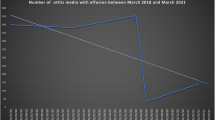Abstract
Objectives
To investigate the incidence and characteristics of adult otitis media with effusion (OME) before, during, and after the COVID-19 pandemic.
Methods
A retrospective descriptive study was conducted. The incidence, age, sex, affected ear side, time of OME onset according to COVID-19 and days of improvement after conservative treatment were determined to assess the clinical features of adult OME in different periods of the COVID-19 pandemic.
Results
The incidence of adult OME during these periods was 3.17%, 2.30%, 6.18%, and 3.68%, respectively. Unilateral ear involvement and male sex were more common. The onset of adult OME occurred 7.80 ± 3.97 days after COVID-19 diagnosis, and improvement was observed after 12.24 ± 5.08 days of conservative treatment. Patients in the post-pandemic period were older than those in the non-pandemic period.
Conclusion
The incidence of adult OME in China showed a tendency to decrease, recover, and decrease again following the COVID-19 outbreak. Pandemic prevention and control measures have had a certain impact on reducing the incidence, but the elderly are more prone to this disease.


Similar content being viewed by others
Availability of data and materials
The authors confirm that the data supporting the findings of this study are available within the article.
References
Deng YK, Shi KT, Liu Z et al (2023) Persistent olfactory dysfunction 2 years after onset of COVID-19. J Infect 86(2):154–225
Umakanthan S, Sahu P, Ranade AV et al (2020) Origin, transmission, diagnosis and management of coronavirus disease 2019 (COVID-19). Postgrad Med J 96(1142):753–758
Storgaard M, Tarp B, Ovesen T et al (2004) The occurrence of Chlamydia pneumoniae, Mycoplasma pneumoniae, and herpesviruses in otitis media with effusion. Diagn Microbiol Infect Dis 48(2):97–99
Hullegie S, Schilder AGM, Marchisio P et al (2021) A strong decline in the incidence of childhood otitis media during the COVID-19 pandemic in the Netherlands. Front Cell Infect Microbiol 11:768377
Rezes S, Söderlund-Venermo M, Roivainen M et al (2009) Human bocavirus and rhino-enteroviruses in childhood otitis media with effusion. J Clin Virol 46(3):234–237
Redlberger-Fritz M, Kundi M, Aberle SW et al (2021) Significant impact of nationwide SARS-CoV-2 lockdown measures on the circulation of other respiratory virus infections in Austria. J Clin Virol 137:104795
Wan Z, Lu R, Zhao Y et al (2022) Diagnostic strategy of SARS-CoV-2 for containment under China’s zero-COVID-19 policy. J Infect 85(1):e7–e9
Garcia Godoy LR, Jones AE, Anderson TN et al (2020) Facial protection for healthcare workers during pandemics: a scoping review. BMJ Glob Health 5(5):e002553
Kourelis K, Angelopoulou M, Goulioumis A et al (2022) Surgery for adenotonsillar hypertrophy and otitis media in children is less demanded in quarantine times. Int J Pediatr Otorhinolaryngol 158:111169
Sungnak W, Huang N, Bécavin C et al (2020) SARS-CoV-2 entry factors are highly expressed in nasal epithelial cells together with innate immune genes. Nat Med 26(5):681–687
Jaillon S, Berthenet K, Garlanda C (2019) Sexual dimorphism in innate immunity. Clin Rev Allergy Immunol 56(3):308–321
Chen N, Zhou M, Dong X et al (2020) Epidemiological and clinical characteristics of 99 cases of 2019 novel coronavirus pneumonia in Wuhan, China: a descriptive study. Lancet 395(10223):507–513
Tharpe AM, Bess FH (1999) Minimal, progressive, and fluctuating hearing losses in children. Characteristics, identification, and management. Pediatr Clin N Am 46(1):65–78
Chonmaitree T, Revai K, Grady JJ et al (2008) Viral upper respiratory tract infection and otitis media complication in young children. Clin Infect Dis 46(6):815–823
Koivunen P, Kontiokari T, Niemelä M et al (1999) Time to development of acute otitis media during an upper respiratory tract infection in children. Pediatr Infect Dis J 18(3):303–305
Stangerup SE, Sederberg-Olsen J, Balle V (1992) Auto inflation as a treatment of OME. A randomized controlled study. Arch Otolaryngol Head Neck Surg 118(2):149–152
Acknowledgements
The authors thank all patients for their participation.
Funding
This work was supported by the National Natural Science Foundation of China (Grant No. 82271180 and 81600793) and Natural Science Foundation of Anhui Province (Grant No. 1608085QH224).
Author information
Authors and Affiliations
Corresponding authors
Ethics declarations
Conflict of interest
The author(s) declare no competing interests.
Research involving human participants
Yes, and this study was approved by the research ethics board of our center.
Informed consent
We have got the permission of all the participants.
Additional information
Publisher's Note
Springer Nature remains neutral with regard to jurisdictional claims in published maps and institutional affiliations.
Rights and permissions
Springer Nature or its licensor (e.g. a society or other partner) holds exclusive rights to this article under a publishing agreement with the author(s) or other rightsholder(s); author self-archiving of the accepted manuscript version of this article is solely governed by the terms of such publishing agreement and applicable law.
About this article
Cite this article
Qi, X., Zhang, K., Wang, Y. et al. Incidence and characteristics of otitis media with effusion in adults before, during, and after the COVID-19 pandemic. Eur Arch Otorhinolaryngol 281, 2275–2280 (2024). https://doi.org/10.1007/s00405-023-08338-6
Received:
Accepted:
Published:
Issue Date:
DOI: https://doi.org/10.1007/s00405-023-08338-6




